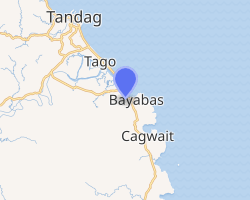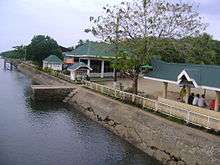Bayabas, Surigao del Sur
Bayabas, officially the Municipality of Bayabas (Surigaonon: Lungsod nan Bayabas; Tagalog: Bayan ng Bayabas), is a 5th class municipality in the province of Surigao del Sur, Philippines. According to the 2015 census, it has a population of 8,164 people.[3]
Bayabas | |
|---|---|
| Municipality of Bayabas | |
 Highway showing a bridge on the main road of Bayabas | |
 Seal | |
 Map of Surigao del Sur with Bayabas highlighted | |
OpenStreetMap 
| |
.svg.png) Bayabas Location within the Philippines | |
| Coordinates: 8°58′N 126°16′E | |
| Country | |
| Region | Caraga (Region XIII) |
| Province | Surigao del Sur |
| District | 1st District |
| Barangays | 7 (see Barangays) |
| Government | |
| • Type | Sangguniang Bayan |
| • Mayor | Maria Clarita Garcia-Limbaro |
| • Vice Mayor | Apolonio B. Lozada |
| • Congressman | Prospero A. Pichay Jr. |
| • Electorate | 6,445 voters (2019) |
| Area | |
| • Total | 117.84 km2 (45.50 sq mi) |
| Population (2015 census)[3] | |
| • Total | 8,164 |
| • Density | 69/km2 (180/sq mi) |
| • Households | 1,710 |
| Economy | |
| • Income class | 5th municipal income class |
| • Poverty incidence | 41.1% (2015)[4] |
| • Revenue (₱) | 51,856,165.84 (2016) |
| Time zone | UTC+8 (PST) |
| ZIP code | 8303 |
| PSGC | |
| IDD : area code | +63 (0)86 |
| Climate type | tropical rainforest climate |
| Native languages | Surigaonon Agusan language Cebuano Tagalog |
| Website | www |
Geography
Bayabas is located between Tago and Cagwait. The Tago River separates the municipalities of Tago and Bayabas. Bayabas is consist of seven barangays mostly located along the coastlines. Though Bayabas is a small municipality, it is also abundant in natural resources especially seafoods.
Barangays
Bayabas is politically subdivided into 7 barangays.
Climate
| Climate data for Bayabas, Surigao del Sur | |||||||||||||
|---|---|---|---|---|---|---|---|---|---|---|---|---|---|
| Month | Jan | Feb | Mar | Apr | May | Jun | Jul | Aug | Sep | Oct | Nov | Dec | Year |
| Average high °C (°F) | 27 (81) |
27 (81) |
28 (82) |
29 (84) |
30 (86) |
29 (84) |
29 (84) |
30 (86) |
30 (86) |
29 (84) |
29 (84) |
28 (82) |
29 (84) |
| Average low °C (°F) | 23 (73) |
23 (73) |
23 (73) |
23 (73) |
24 (75) |
24 (75) |
24 (75) |
24 (75) |
24 (75) |
24 (75) |
24 (75) |
23 (73) |
24 (74) |
| Average precipitation mm (inches) | 161 (6.3) |
132 (5.2) |
112 (4.4) |
87 (3.4) |
136 (5.4) |
169 (6.7) |
146 (5.7) |
148 (5.8) |
132 (5.2) |
156 (6.1) |
176 (6.9) |
170 (6.7) |
1,725 (67.8) |
| Average rainy days | 20.0 | 16.2 | 18.3 | 17.5 | 24.0 | 26.7 | 27.5 | 27.5 | 26.5 | 26.4 | 23.8 | 21.1 | 275.5 |
| Source: Meteoblue [5] | |||||||||||||
History
World War II
During 1943 and 1944 much of the east coast of Mindanao was occupied by the Japanese. Bayabas was not occupied, although at times Japanese navy ships anchored in the harbor off the coast of the town. As the Japanese occupied an increasing number of area coastal towns, refugees trickled into town. The prewar rector of San Nicolas School, in Surigao City, was one of a number of priests who sought refuge in Bayabas. Food supplies soon failed to reach town from the outside, since Japanese troops disrupted distribution.[6]
Demographics

| Year | Pop. | ±% p.a. |
|---|---|---|
| 1970 | 4,810 | — |
| 1975 | 4,859 | +0.20% |
| 1980 | 5,881 | +3.89% |
| 1990 | 6,259 | +0.62% |
| 1995 | 6,423 | +0.49% |
| 2000 | 7,706 | +3.98% |
| 2007 | 7,439 | −0.49% |
| 2010 | 7,779 | +1.64% |
| 2015 | 8,164 | +0.92% |
| Source: Philippine Statistics Authority[3][7][8][9] | ||
References
- "Municipality". Quezon City, Philippines: Department of the Interior and Local Government. Retrieved 31 May 2013.
- "Province: Surigao del Sur". PSGC Interactive. Quezon City, Philippines: Philippine Statistics Authority. Retrieved 12 November 2016.
- Census of Population (2015). "Caraga". Total Population by Province, City, Municipality and Barangay. PSA. Retrieved 20 June 2016.
- "PSA releases the 2015 Municipal and City Level Poverty Estimates". Quezon City, Philippines. Retrieved 12 October 2019.
- "Bayabas: Average Temperatures and Rainfall". Meteoblue. Retrieved 19 November 2019.
- Virginia Hansen Holmes, Guerrilla Daughter (Kent, Ohio: Kent State U. Press, 2009), pp. 141-1, 166, 205.
- Census of Population and Housing (2010). "Caraga". Total Population by Province, City, Municipality and Barangay. NSO. Retrieved 29 June 2016.
- Censuses of Population (1903–2007). "Caraga". Table 1. Population Enumerated in Various Censuses by Province/Highly Urbanized City: 1903 to 2007. NSO.
- "Province of Surigao del Sur". Municipality Population Data. Local Water Utilities Administration Research Division. Retrieved 17 December 2016.
External links
| Wikimedia Commons has media related to Bayabas, Surigao del Sur. |